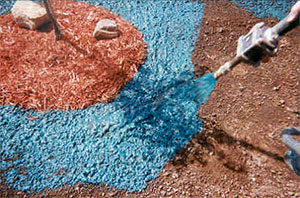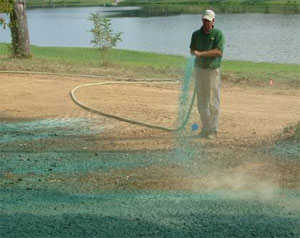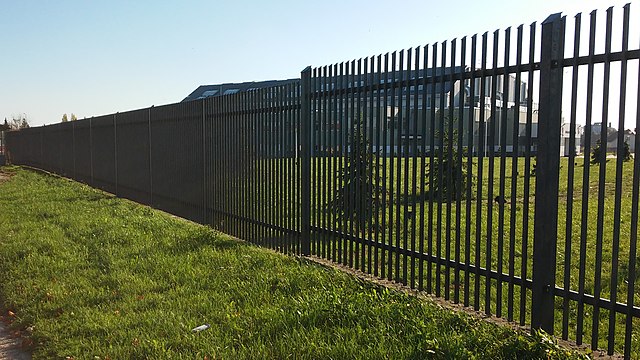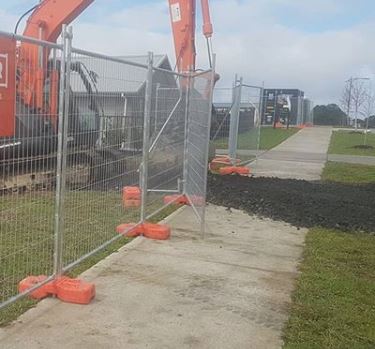What is Hydroseeding?

Why Choose Hydroseeding for a Healthy Lawn?
This method may give you the best chance of a beautiful lawn in the long term. With hydroseeding, a healthy lawn can be planted on almost any kind of surface. Grass can grow quickly and thrive with this technique, even if the land is uneven or has a slope. It’s easy to fill in patchy areas by simply respraying the mixture over the affected area.
Your grass seed will be shielded from wind, soil erosion, and sunlight with a combination of mulch and moisture. The mixture used in hydromulch grass releases a variety of nutrients designed to help your seeds thrive. When a fairly large area of ground has to be planted in grass, the be a quick solution to establish healthy turf. Hydroseeding is an effective method for establishing new lawns for residential and commercial customers using a slurry mix of mulch, seed, fertilizer, and water.
Hydroseeding also helps crowd out and reduce the presence of weeds in your lawn. This proven process has been around for more than a half-century and is the best way to get fast and widespread ground cover. Hydroseeders hydraulically spray hydromulch, seed, fertilizer and additives. Hydroseeding is ideal for inactive lots, backyards, front entrances and paths. The cost does tend to be more expensive than planting dry seed, but the process is considerably cheaper than planting with sod.
This article covers Types of Soil Erosion and Mitigation Strategies. Biodiversity Leads to Resilience and Soil Health!Using only one type of grass creates a monoculture. Monocultures are more susceptible to disease and pests than mixtures. A mix of different types of seeds promotes diverse soil bacteria that protect plants and supply them with nutrients. Homeowners and property managers should always use a blend of different types of grass for lawns. With hydroseeding, you can create your own seed mixture. Discuss your needs with your service provider so they can select a mixture of grass species that suits your property and personal preferences. These lawns will be more attractive, as you can orchestrate exactly the color and texture of grass that you want.
This article offers information about How to Estimate Sitework and Site Work Costs. Hydroseeding is Excellent for Large SpacesYou can save money by choosing to hydroseed your yard – the bigger your property, the more you can save. Consider the amount of labor involved in rolling out and installing sod over expansive spaces. Hydroseeding is an effective solution for mitigating soil erosion. When you lay down the slurry mixture over a steep slope in danger of eroding, the seed takes root quickly, offering a fast solution to the problem of loose ground and potential landslides.
The Process of Hydroseeding – How It’s Done

Technicians must first prepare the soil to get the ground ready to apply the seed with the best possible chance of fast and healthy germination. Be sure to grade the soil away from structures before spraying the hydroseeding slurry next to a building. The grade should drop by at least two inches every 100 feet. This will prevent the slurry moisture from running towards the building and causing moisture damage. It is also important to examine the topsoil to ensure it meets the necessary soil conditions for successful hydroseeding. Then you’ll schedule a time for the technician to return with the hydroseeding truck, to apply the slurry using a hose and nozzle. The service will likely post signs or barriers around the area, so people will know not to step onto the field or lawn while the new grass is getting started.
The fertilizer in the slurry mixture boosts growth, the mulch bonds the seeds to the soil, protects them from the elements (like wind or too much sunlight), and ultimately adds extra nutrients by decomposing and feeding soil microbes. Keep in mind that soil preparation is important so you should try to follow the instructions given to you by the technician you hire as closely as possible. Once the slurry is mixed, the application must happen quickly. The seed can’t stay within the hydroseeding equipment for longer than an hour or it may be damaged by the fertilizer and water it’s mixed with. There are environmental concerns when sprayed over large areas as fertilizer application can lead to runoff.
To avoid the over application of the slurry material, a green dye is usually included. This makes it easy to see as it’s being laid down and allows the people applying it to see where they’ve already sprayed. It’s important to keep the mulch wet at all times during the first couple of weeks after the spraying is over. Two or three light sprinkles with water each day will promote the growth of a healthy lawn. You can back off to only one or two sprinkles for the next couple of weeks after that. Be careful not to allow puddles to form on the lawn. Additionally, applying starter fertilizer two weeks after hydroseeding is crucial to promote growth and maintenance of the lawn. This is a great article about What is Soil Stabilization in Road Construction.
When is the Best Time of Year to Hydroseed?
A hydroseed application must occur immediately before the best growing season for the specific grass seed being used. Generally, Hydroseeding erosion control should be applied during the early spring when the weather is cool and wet. Under these circumstances, the soil is more likely to maintain moisture levels that are ideal for germination. The soil type is crucial in hydroseeding as it affects the watering frequency and the growth of green turf. The grass will have plenty of time during the summer and fall to develop and grow before winter’s freezing temperatures and crushing snow hit.
Here's a great post if you're looking for information about Dealing With Foundation Drainage Issues.How Long Does it Take for Hydroseeded Grass to Grow?
Grass seed planted via hydroseeding germinates quickly because of growth enhancers in the slurry. Grass sprouts and begins to become visible in about one week and as the lawn begins to fill in, you may need to perform additional seeding in thin areas. By the time three or four weeks have passed, it becomes necessary to maintain it with a lawnmower. Approximately 5 weeks after hydroseeding, the first mowing should be done, with recommendations to keep the grass height at about 3 inches and to use a push mower for the best results.
Hydroseeding vs Sod and Traditional Dry Seeding
At Eastcoast Sitework, we understand that choosing the right method for establishing a lawn can be challenging. With options like laying sod, traditional seeding, and hydroseeding, it’s essential to weigh the advantages and disadvantages of each. Hydroseeding has gained popularity due to its quicker establishment compared to traditional grass seed methods. However, unlike sod, it doesn’t provide an instant lawn.
One significant advantage of hydroseeding is the ability to use a custom blend of grass types, tailored to suit your property’s specific needs. Sod, on the other hand, typically offers only one species of grass. Our hydroseeding solutions help reduce dust pollution during application and suppress weed growth. Moreover, this versatile method allows for planting ground covers such as wildflowers. Despite requiring large amounts of water in the process, hydroseeding is usually less expensive than sod, making it worth the cost for larger lawns. To ensure the new lawn grows strong and healthy, it is crucial to follow proper aftercare steps, including regular watering, fertilizing, mowing, and dealing with weeds.
Sod is the quickest option for a finished lawn but comes at a higher price. Additionally, sod may be less hardy due to its compromised root system from being grown, cut, and installed. Traditional seeding remains the most affordable choice, but it takes longer to apply and establish. A lawn seeded traditionally may take 6 to 10 weeks before it can handle foot traffic. When considering whether hydroseed is better than sod, it’s essential to evaluate factors like cost, desired grass types, and time for establishment.
Hydroseeding does work, and our spray grass seed techniques, including spray-on grass seed and hydro mousse liquid lawn applications, ensure efficient and even distribution. We also offer spreading grass seed services and spray-on lawn fertilizers for optimal lawn care. As a New Jersey homeowner or property manager, a healthy and lush lawn is a top priority. Our hydroseeding solutions at Eastcoast Sitework are designed to help maintain your lawn’s impeccable appearance all year long. With our expertise in grass seeds and lawn care, you can trust us to make the right choice for your property.
Frequently Asked Questions
Q: Does hydroseed grow faster than dry grass seed?
A: Yes, hydroseed grows faster than dry grass seed due to the slurry that enhances growth. Seed germination typically occurs within one week. By three to four weeks, the new seed is visible and ready for mowing.Q: Does hydroseeding really work?
A: Yes, hydroseeding is an effective seed germination process used for over half a century. With adequate watering and proper care, it produces robust grass growth.Q: Hydro grass seed cost versus dry grass seed versus sod?
A: Sod is the most expensive option. Hydroseeding is less expensive, and traditional seeding is the cheapest. Costs may vary depending on specific project requirements.Q: Are soil temperatures important for a hydro seed lawn?
A: Yes, soil temperature is crucial for success. The ideal soil temperature for germination is between 60-80 degrees Fahrenheit. Proper care includes monitoring soil conditions closely.Q: Can you hydroseed in the winter?
A: Yes, you can hydroseed in the winter as long as the ground isn't frozen. Adequate watering and a suitable watering schedule are essential to keep the soil moist.Q: What is dormant seeding?
A: Dormant seeding involves seed germination during colder months when the ground is not frozen. It is ideal between late fall and early spring. The soil should remain moist to encourage seed establishment.Additional Resources
- What is a retention pond and why is maintenance important?
- How does Vegetation Help Stabilize Slopes and Prevent Erosion?
- Where Does Stormwater Runoff Go?



